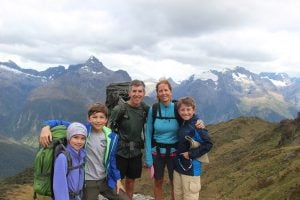
Last year, Professor Timothy Weihs was awarded a Fulbright award to participate in a 12 month sabbatical to New Zealand’s University of Canterbury. Since January, the professor and his family have resided in New Zealand. With almost half of his time in New Zealand over, the professor took time to answer a few questions and share some family photos.
You were selected for the J. William Fulbright Foreign Scholarship Board to receive a Fulbright award to go to New Zealand. What made you apply for the Fulbright Award?
I have always liked the idea of the Fulbright Fellowships and Scholarships – trying to improve understanding across the globe by having people move between countries to undertake projects in host countries. When people from different countries interact over extended periods, they come to understand each other more, as well as the cultures of both countries. A greater appreciation and understanding of other people and cultures helps to build a better world.
How has the adjustment to New Zealand been?
The biggest challenge was learning to drive and bike on the left-hand side of the road. Other than that, the Kiwis have been very welcoming, both inside and outside the University of Canterbury, and our children have settled into their new schools and activities fairly easily. It has been a fun adventure so far.
What research have you been working on currently? How has it been working at the University of Canterbury in Christchurch, New Zealand?
I am hosted by the Mechanical Engineering Department at the University of Canterbury and several faculty members within the department focus on Materials Research, structural materials in particular.
In addition to skyping regularly with my research group back at Hopkins, I have been learning and studying bio-degradable Mg alloys for use as bio-scaffolds for bone growth and as pins, screws, and plates for bone fixation. Professor Mark Staiger here at UC is active in this second application area and I am learning from him, his students, and postdocs. My hope is to leverage our other activities in Mg alloys at JHU and develop a research program in bio-degradable Mg alloys back at Hopkins. These alloys require optimization of their chemistry and microstructure to obtain not only the appropriate strength and ductility, but also effective corrosion rates. Thus, optimization of microstructure is critical and we will attempt to do so with thermal mechanical processing. We are also building relationships with Professors within the JHU School of Medicine to enable animal and clinical trials down the road.

The Weihs family at Tongariro Alpine Crossing
How do you feel your sabbatical has positively impacted your current research?
Having the time to read and think opens the door to new opportunities and activities. Bio-degradable Mg alloys is the first of those areas. Others may arise as well. Having the time to pursue new research topics is a real privilege.
Have you been able to explore New Zealand during your downtime?
We are trying to take advantage of all of the school holidays to explore New Zealand. As a family, we enjoy traveling and hiking and New Zealand provides many opportunities to do both. They have a number of classic single-day and multi-day hikes and we completed two of each. The most memorable two for me were the Routeburn Track (4 days) and the Tongariro Crossing (1 day). The landscape and views were spectacular and on the multi-day hikes you can stay in cabins each night and get to know Kiwis and other travelers. We also completed the Heaphy Track and were lucky enough to meet 3 Kiwi families during the hike. They were staying at the same cabins as us, so our children had playmates and my wife and I had other adults for conversations. 78 kms provided a good bit of time for talking. The three other families were from Wellington, New Zealand’s capital, and when we toured the North Island just recently, we stopped to see the three families. We have been very impressed with the friendly and welcoming nature of the Kiwi people.
What are you looking forward to doing for the rest of the year?
We look forward to exploring more of New Zealand and to traveling to Australia’s Great Barrier Reef in July. Given how far New Zealand is from Maryland, we want to see as much as possible this year. Professionally, I look forward to establishing deeper ties with collaborators here and to creating opportunities with the SOM back at JHU to expand into this new research area of bio-degradable Mg alloys.